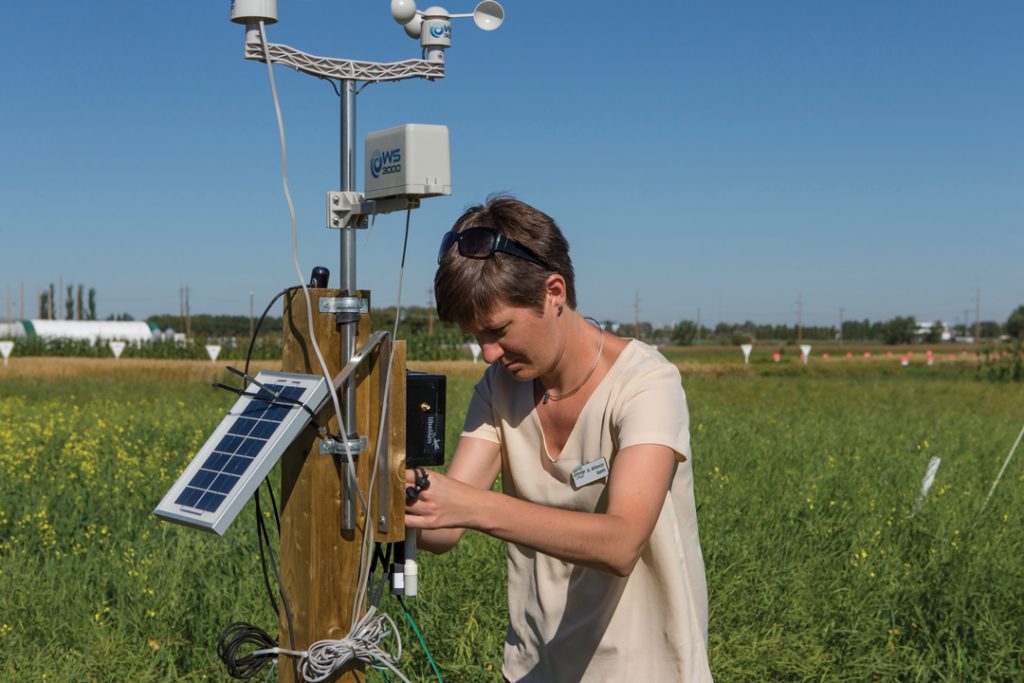SPLASHY SCIENCE
BY ELLEN COTTEE • PHOTOS COURTESY OF LETHBRIDGE COLLEGE
Of all the variables in agriculture, from prices and pests to supplies and sun, water is perhaps the most difficult to manage. Most Alberta farmers may prefer to forget the 2021 season, which illustrated just how damaging a lack of it can be. In southern Alberta, drought can be mitigated by irrigation, and local scientists are at work to improve the practice.
Willemijn Appels, the first Mueller Applied Research Chair in Irrigation Science at Lethbridge College, is one such scientist. Having grown up in the Netherlands, a maritime nation well-accustomed to water, Appels swapped canals and coastlines for rivers and sloughs with a move to Saskatchewan in 2012. Now, she and her Lethbridge colleagues use advanced technology to develop irrigation modelling and best practices to ultimately analyze return on investment and improve Prairie irrigation management. She also leads an Alberta soil water mapping project.
GrainsWest: What drew you to agricultural irrigation?
Willemijn Appels: I studied at Wageningen University in the Netherlands, which is a general university with an agricultural focus. I started with hydrology, but it always had something to do with agricultural ecosystems, drainage ditch levels. There’s nothing too dry around the Netherlands, it was always too wet. My work on my master’s degree in hydrology and my PhD in soil physics also happened to take place in agricultural settings.
I like the agricultural sector because it’s so dependent on water. It needs water, it affects water bodies, it can receive too much or too little water. It seemed like a natural fit, even though I’ve never farmed.
GW: You came to Canada to work on a postdoctoral project at the University of Saskatchewan. Did that start your journey in Canadian agriculture?
WA: I worked on oilsands projects with a little bit of ag, mostly dryland. My research was focused on investigating spatial patterns of soil over fields or vegetation and how it affects the way water moves through a system or is available in a landscape. In the case of oilsands reclamation, we worked on making water balances to ensure there wasn’t too much water, which would kill the trees.
Then this position popped up in Lethbridge, and I figured getting water onto a crop is pretty much the same as getting it off the field, so here I am.
GW: Since 2016, you have filled the position of Mueller Applied Research Chair at Lethbridge College. What does the role entail?
WA: As a research chair in the Centre for Applied Research, I am a full-time researcher, although I do interact with students and employ them in our projects. My focus is really to come up with projects in collaboration with local or regional industry partners that help use water more effectively and efficiently. Everyone needs food, and we all realize we need to work to grow these plants. That is what I would like my work to contribute to.

GW: Your irrigation group is working on a three-year soil water mapping project with $420,000 in funding from Results Driven Agriculture Research. What do you hope to accomplish with this research?
WA: This is an exciting project. The difficulty in doing precise irrigation work is that the sensors we normally use to measure water in the soil take a point scale measurement representative of a very small area. It would be the same as if you were just to take up one handful of soil. A litre of soil can contain 400 millilitres of water where we stand, but two metres away it’s 200 millilitres. It’s not feasible to put thousands of those sensors into the soil at different depths and locations to accurately measure an entire field.
Now we have new sensor technology that uses microwave radiometer techniques to measure the reflectance in the microwave spectrum of the soil to determine how much water is present in about the top half metre of soil. This type of sensor could be used to map out moisture over an entire field instead of just in one small volume location. It’s a really promising way to create a 2D map.
We’re working to come up with ways to take the data collected with the sensor and turn it into information for the farmer. I have students who measure soil moisture contents under different irrigation regimes, different depths and different time frequencies to see when it matches up with the sensor observations and when it breaks down.
GW: What are the challenges in using this technology?
WA: There are still some technical issues to work out. It is a bit sensitive to the water present in the crop, for instance. A potato crop would possibly tweak that signal a bit differently than a wheat or barley crop. Then there’s the aspect that this technology measures the total amount of water and not necessarily how much is available to the plant, which is what you want to know as an irrigator.
It is quite a big project, and I think it highlights Lethbridge College’s strengths. And my group’s strength is very much on the ground. We understand soil and the interactions [of water] with topography.
We’ve teamed up with the University of Alberta’s Control Systems group, a Department of Engineering team that analyzes data and designs algorithms to ensure electric and mechanical systems perform well. They are trying to incorporate [this technology] into this larger system for enhanced control and decision-making over irrigation. We also have our industry
partner Skaha Labs who developed the initial technology, but is interested in seeing how we can make it into a product that helps the irrigated agricultural sector.
GW: In 2020, the Alberta government transferred management of the Alberta Irrigation Technology Centre (AITC) in Lethbridge to Lethbridge College. This soil mapping project, along with many others at the college, takes place on the AITC test farm. How has this move changed your research processes?
WA: The move gave us mixed feelings. It was a wonderful facility already, and the loss of capacity and knowledge is felt, as the previous team of researchers and professionals that worked at the AITC are no longer there. However, for the college, it does mean we can now do our own controlled studies and continue to work with partners to ensure the mission of the centre can continue.
With this space, we are able to designate areas in our subsurface drip irritation field and under our variable rate irrigation pivots where we apply water strictly according to an alternative management strategy, such as withholding irrigation applications during certain growth stages. We can then evaluate the impacts on yield or crop water use efficiency. The more extreme strategies may cause crop or yield loss unacceptable to a commercial farmer, but this is important to evaluate in the framework of a research project.
Being able to work on this farm has really taken the experimentation part of our research to a new level. We can design treatments, lay them out in plots and control the distribution of water, nutrients and tillage. We’re definitely grateful this was handed to us.
GW: What emerging developments in irrigation are you most excited about?
WA: Moving to the implementation phase of this new technology and data [from the soil mapping project]. A lot of people have found there is no silver bullet solution to better irrigation. There’s now this realization we need to bring together different tools and data sets to build a decision-making system for efficient, effective irrigation. We see this in research, these different fields of tech, data and on-farm research finally starting to come together.







Comments